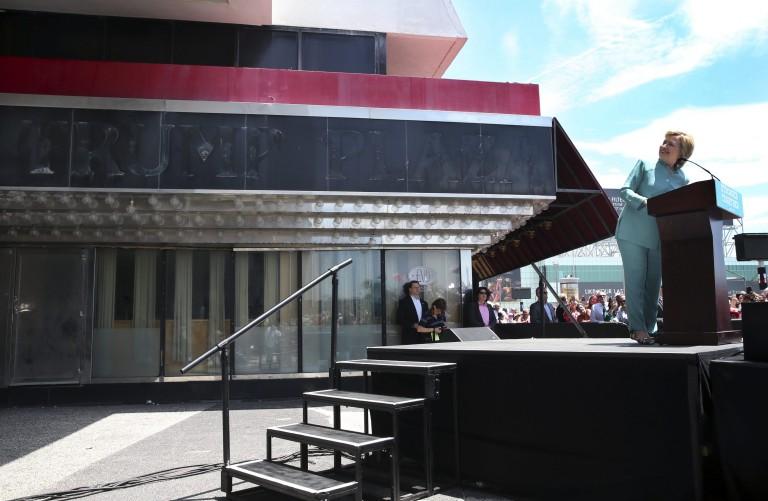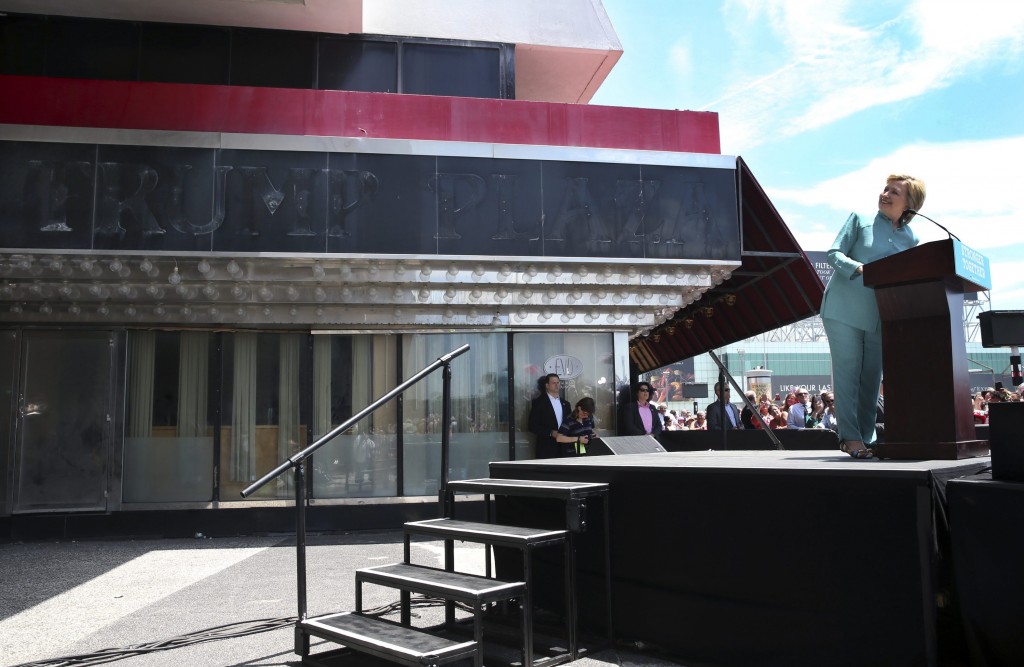What this photo tells us about Clinton’s Trump problem
The flip side of a photo-op: As much as Clinton may try to paint her rival as a con man, he looms as a symbol of change

Democratic presidential candidate Hillary Clinton looks back at the faded sign of the former Trump Plaza as she speaks in Atlantic City, N.J., Wednesday, July 6, 2016. Trump Plaza closed permanently on Sept. 16, 2014. (AP Photo/Mel Evans)
Share

In a story in the New York Times last week, about Donald Trump’s appeal in rural Pennsylvania, there was a comment from Paul Myers, a 50-year old steelworker. He said: “Trump might be lying about bringing jobs back, but at least he’ll try to.”
A few days after that story hit the presses, Hillary Clinton showed up in Atlantic City to give a speech. Her venue: Trump Plaza casino and hotel—or, what was once Trump Plaza, but is now a giant, empty building. Like most things in a political campaign, this was deliberate. “What he did here in Atlantic City is exactly what he will do if he wins in November,” Clinton told a friendly crowd. And what did he do? According to Clinton, Trump ran his casinos there into the ground.
“The people he is trying to convince to vote for him now are the same people he’s been exploiting for years,” Clinton warned. “Working people, small-business people, trying to support their families.” People, presumably, like Paul Myers.
One wonders what Myers might have seen were he to have been watching this Clinton speech. Would he have seen what Clinton’s team wanted—a glittering monument to money and chance now hollowed out and faded? Or might he have seen something else, something the Clinton camp didn’t think they were showing?
It is perhaps too easy to conflate cross-Atlantic political movements, but there is at least one lesson that those who want things to remain the same in America can borrow from the June referendum on Britain’s EU membership.
The Remain camp in the U.K. didn’t anticipate a lot of things, but what it seems it missed most of all was that change is very enticing, no matter what kind of change that is. As Vince Cable told the Guardian for its retrospective of the ultimately doomed campaign: “There were people turning up who had never voted before. They did it this time because they were very angry with what they felt had been done to them in their communities over decades—the decline of industry, the rapid increase in people coming to this country, the levels of austerity. In a general election they might think it doesn’t matter who you vote for because they’re all the same. In a referendum they recognized this could lead to something different. Maybe they didn’t anticipate all the consequences. But there was a sense that you could change things.”
The election in November, thanks to Trump, has the feeling of a referendum: a choice between the way politics and public policy has always been done, and something altogether different. Americans have the chance to make something happen, which means, as it did for many Britons, their vote suddenly feels as if it is worth something.
No doubt Hillary Clinton gets that. Right?
Take another look at this picture—one the Clinton camp was surely quite pleased with. They wanted us to see those faded letters and those sad curtains and those empty rooms. To see their candidate as they see her: brightly standing to the side, surveying the damage, somewhat amused. As for “those people” that Trump is trying to exploit, they don’t understand, she seemed to be saying. They will get conned again this fall.
The problem with this talk is the issue of Trump Plaza itself—her backdrop. We can’t help but notice how it dominates the frame. Even Clinton has to look back and up at it to bring it into proper perspective. It is looming and hulking, just like its former namesake, over this election event. It is something Trump (ostensibly) built. People once worked there. Other people even might have become richer there. It once held promise. And now, still, despite all its faults, it is noticeably not going anywhere. It is just waiting, biding its time before it takes on the next opportunity.
In the end, despite all the perfect, obvious ironies and symbolism the Clinton team worked to showcase, all she might have done was to remind Americans of what Trump has accomplished—in other words, the very narrative he sells when he sells himself.
“There’s nobody like me. Nobody,” Trump told a crowd in Florida earlier this year. “I ask people to look at what I’ve done throughout my whole career. Look at how successful I’ve been doing things my way. So they have a choice: They can pretend some impossible solution is actually going to happen, or they can listen to the person who has proved that he can solve problems.”
Clinton sees that choice as a con. Others—“the people” Clinton talked about, out there, somewhere in America—might just see it as change. She may soon learn there are more of them than she thinks.